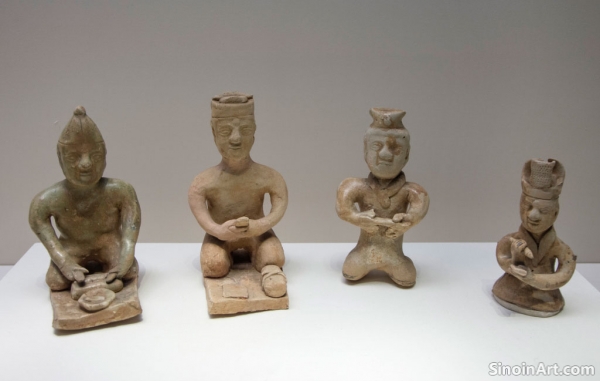Sancai Glazes: A Tang Dynasty Innovation
|
The three-color (sancai) glazes are perhaps the most recognizable and celebrated innovation of Tang Dynasty ceramics. These lead-based glazes, in shades of green, amber, and cream, were used to decorate a wide range of objects, from tomb figures to everyday vessels. Sancai represents a major development in the world of ceramics.  The application of sancai glazes involved a complex process of carefully applying different glazes to the pottery body and then firing it at a relatively low temperature. The way the glazes mixed and flowed created a distinctive, variegated effect. Each piece is unique in its distribution of colors.  The colors of sancai glazes are derived from metallic oxides added to the lead-based frit. The green color is created by adding copper, the amber color by adding iron, and the cream color by the base lead glaze itself. The combination of these colors together is the hallmark of the sancai glaze.  Sancai wares were not only decorative but also functional. They were used for burial goods, household items, and even architectural elements. The versatility of sancai made it a key part of the ceramic production of the Tang era. These pieces served many purposes both in life and in death. The enduring appeal of sancai lies in its vibrant colors, its unique textures, and its reflection of the cosmopolitan spirit of the Tang Dynasty. Sancai wares are an instantly recognizable icon of the Tang dynasty. The beauty and complexity of sancai ware remains highly prized today. |
Tag : Sancai glazes, Tang Dynasty pottery, Chinese ceramics, Three-color pottery, Lead glazes
Related information
- Technological Advances in Tang Kilns
- Burial Goods and the Afterlife in Tang Ceramics
- Tang Dynasty Tomb Figures: A Window into the Past
- The Influence of the Silk Road on Tang Ceramics
- Collecting and Appreciating Tang Ceramics Today
Tang Dynasty advancements in kiln technology, such as high-firing kilns and lead glaze control, enabled potters to produce a greater variety of higher-quality ceramics, significantly influencing later ceramic traditions.
The Tang Dynasty saw the flourishing of an elaborate burial culture, with ceramics playing a central role in equipping the deceased for the afterlife. These funerary wares, from everyday objects to elaborate figurines, offer a fascinating glimpse into Tang beliefs about death, the spirit world, and the continuation of earthly life in another realm. These burial goods were not just functional; they were imbued with symbolic meaning and designed to ensure the comfort and prosperity of the deceased.
Tang Dynasty tomb figures, often decorated with sancai glazes, provide insights into the era's daily life, fashion, and beliefs, depicting court ladies, officials, soldiers, and animals, reflecting detailed craftsmanship and vibrant artistry.
The Tang Dynasty was a period of unprecedented prosperity and cultural exchange, largely due to the flourishing of the Silk Road. This network of trade routes not only facilitated the exchange of goods but also ideas and artistic styles. The influence of the Silk Road on Tang ceramics is undeniable, introducing new techniques, materials, and decorative motifs that transformed the landscape of Chinese pottery. The interaction between different cultures created a vibrant and cosmopolitan atmosphere reflected in the artistic output of the time.
Tang Dynasty ceramics are highly valued by collectors and museums for their historical significance, artistic beauty, and technical innovation, requiring a detailed understanding for informed collecting and appreciation of these important cultural artifacts.